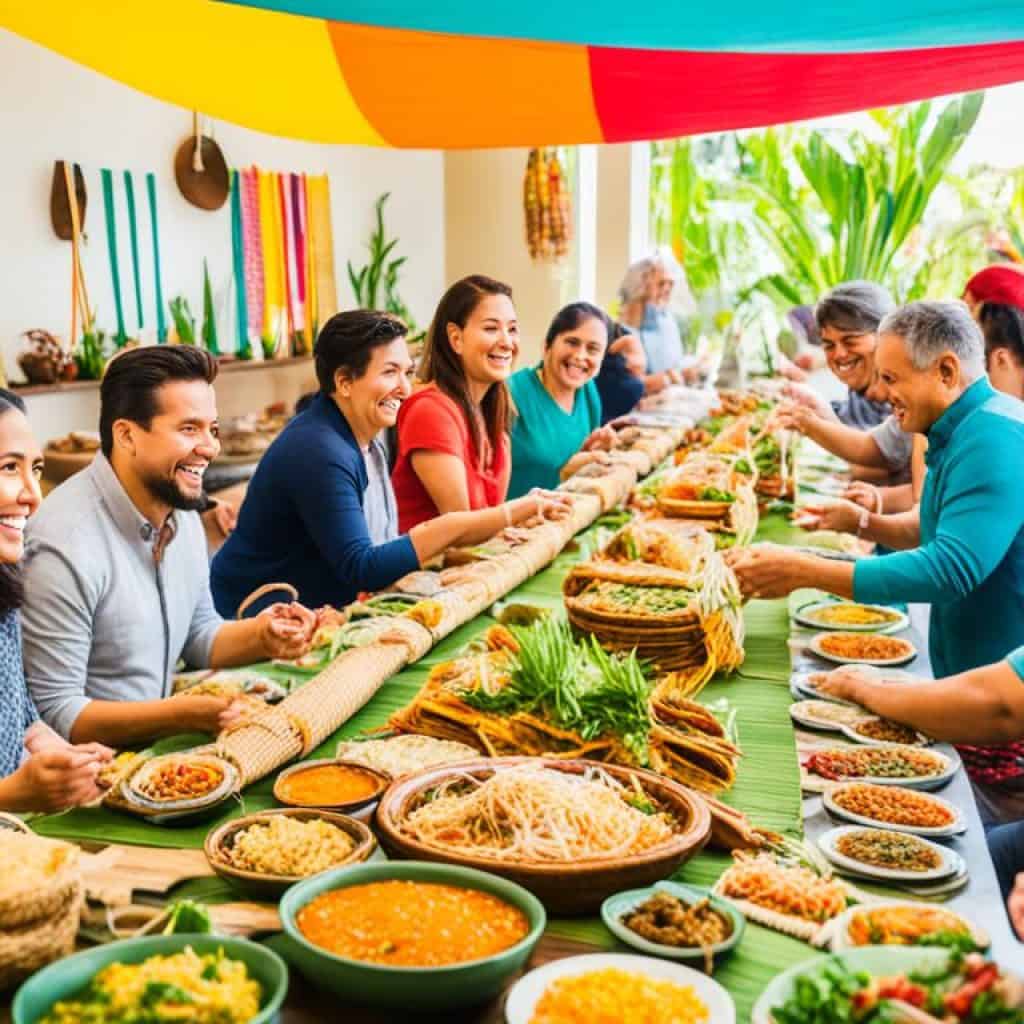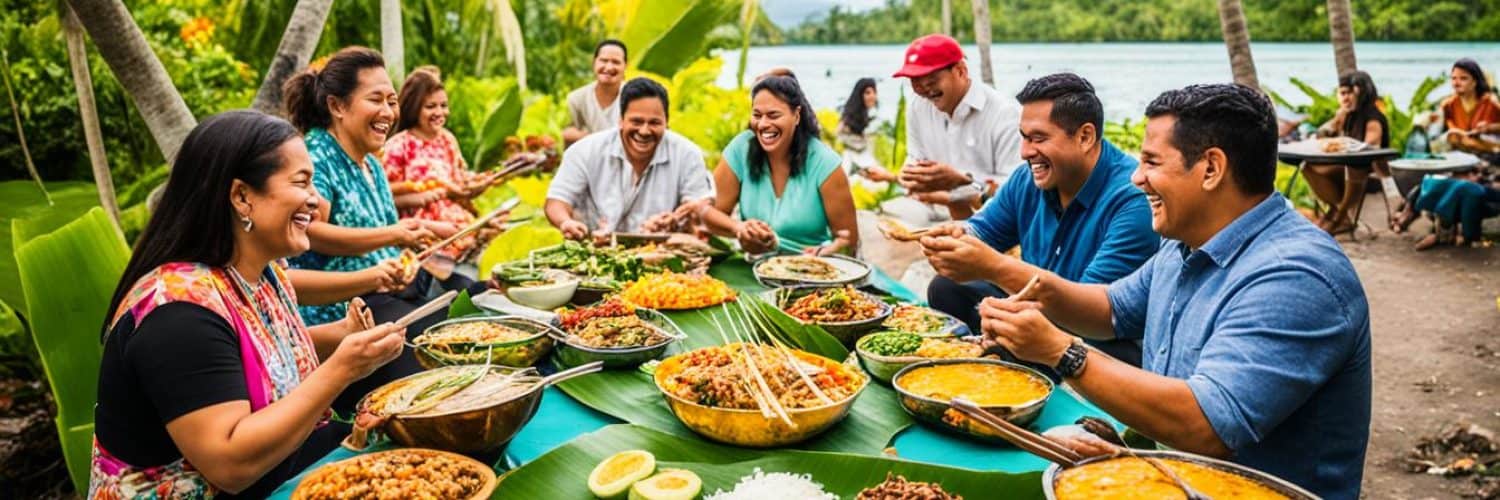Do you have a keen interest in the diverse culture of the Philippines? Discover its unique blend of traditions, customs, and lifestyle. This country stands out as the only mainly Christian nation in Southeast Asia.
It has a mix of Spanish, American, and its own indigenous roots. Ready to learn more about Filipino culture and its rich history? Let’s dive in together.1
In this guide, we’ll share inside knowledge about Filipino culture. You’ll learn how to speak the language and get to know their ways. We’ll explore the country’s vibrant art, music, and food. This will help you truly embrace the Filipino lifestyle.
Preparing for a visit to the Philippines? Or maybe you just want to broaden your cultural understanding. This journey will introduce you to the lively and captivating world of Filipino culture.2
Key Takeaways
- The Philippines is a diverse and vibrant country with a rich cultural heritage, influenced by Spanish, American, and indigenous traditions.
- Filipinos are known for their warm hospitality, strong sense of community, and unwavering resilience and adaptability.
- Understanding the Filipino language, customs, and traditions is crucial for a deeper appreciation of the country’s cultural landscape.
- Immersing oneself in the Philippines’ art, music, cuisine, and festivals can provide a deeper insight into the nation’s cultural identity.
- Embracing the core values and beliefs that shape Filipino society, such as the importance of family and the concept of bayanihan, can enhance your cultural experience.
Embracing the Filipino Warmth and Hospitality
Filipinos stand out for being warm and friendly, making this their cultural trademark.3 They believe in bayanihan, which is all about community and working together. This spirit shows in how they unite to help, like moving a house or aiding someone in need. They are also very adaptable and keep their sense of humor alive, no matter the challenge.3 This shows their strong spirit to stay positive and resilient.
Exploring the Concept of Bayanihan
The idea of bayanihan is a key part of Filipino life.3 It means they work as one, always ready to support each other. This culture of togetherness shapes their daily activities, big or small.3 By joining forces, they feel like they belong and grow even stronger. It also reminds them of the value of helping each other in hard times.
Understanding Filipino Humor and Adaptability
Filipinos are famous for keeping spirits high, no matter what.3 Their ability to laugh and remain cheerful is truly remarkable. They joke or find new ways to fix things during tough moments. This positive approach is something they deeply value, and others admire them for it.3
Exploring Philippine Philosophy and Religious Beliefs
The Philippines is known for its deep spirituality and religion. It has a mix of filipino philosophy and filipino religious beliefs. These ideas like hiya and utang na loob guide how people interact.4
Unpacking the Concepts of Hiya and Utang na Loob
People in the Philippines live by the principles of hiya and utang na loob. Hiya means feeling shame or embarrassment in front of others. It affects their behavior in social settings.
Utang na loob is about feeling like you owe a debt to those who help you. It shapes how they treat friends and family. These ideas are central to their way of life.
Embracing the Bahala Na Mentality
Filipinos also have the bahala na mindset. It mixes accepting fate with trust in a higher power. This belief helps them face challenges with courage.
It can offer peace of mind. Yet, some debate if it affects their problem-solving skills. Overall, it plays a big part in their everyday lives.
Discovering Filipino Superstitions and Christianity
The country is mainly filipino christianity, with many being Roman Catholic.4 Even with this, old filipino superstitions persist. They are a mix of local and foreign beliefs.
This blend makes the philippines religious culture diverse. It shows the depth of its philosophical beliefs too.
Navigating Family and Work Values in Filipino Culture
Family means everything in Filipino culture. You can see it in the tight-knit families and big family networks in the Philippines.5 Many Filipinos stay with their parents and other family members as they grow up. They see their kids as support during their elderly years. This view is strong. It means children should care for their parents later in life. At work, professionalism is key for Filipinos. They work hard to keep a good name. This means they avoid anything that might make them look bad.6 Also, they really care about not losing face. It affects how they talk and work with others in Filipino work culture.
| Characteristic | Filipino American Families | Korean American Families |
|---|---|---|
| Familism | More traditional aspects of familism6 | Less traditional aspects of familism6 |
| Youth Outcomes | Better grades and lower rates of crimes, substance use, and risky sexual behaviors6 | Higher depression and suicide rates compared to other backgrounds6 |
| Cultural Influences | Blend of traditional and Western family processes6 | Largely preserve traditional family dynamics influenced by Confucianism, Taoism, and Mahayana Buddhism6 |
In the Philippines’ work culture, keeping a good name is vital. Avoiding shame is a big deal too. These values are behind how Filipinos behave with others at work.6 They also come from strong Filipino family values and a culture of lots of relatives. These have a big impact on how Filipinos work and live. They juggle their job duties with their family commitments.
In general, the cultural values and social networks in the Philippines shape how both families and workplaces run. They are central to Filipinos’ lives, at home and work.
Immersing Yourself in Filipino Art and Traditions
The Philippines has a splendid artistic history, blending cultures from all corners.7 Its arts scene, from visual to performing arts, is alive and well, showing off a rich cultural sector.7 Weaving, regional music, and dancing are windows into the nation’s culture.7 In the crafts industry, artisans make detailed pieces that mirror tradition.
Appreciating Filipino Music and Dance
Filipino culture greatly values music and dance, each filled with history and variety.7 The nation’s performing arts include traditional plays, dancing, and a mix of music genres that tell powerful stories.8 Arnis, a martial art, is the local sport, symbolizing the country’s vibrant heritage.
Exploring Traditional Filipino Festivals
Events like the Sinulog and Dinagyang Festivals are exuberant shows of Filipino traditions, with their bright clothes and songs.7 These cultural celebrations highlight the nation’s arts and other cultural aspects in a lively way.8 Christmas and New Year are special, marked by ‘Noche Buena’ and wearing polka dots.
To truly know the Philippines, diving into its festivals and customs is key.

Savoring the Flavors of Filipino Cuisine
Filipino cuisine is full of life and rich tastes, showing the nation’s mix of cultures.9 Iconic dishes like adobo, a mix of meat or veggies in soy sauce, vinegar, and spices, stand out.9 There’s also Bicol Express from the Bicol region and Kare-Kare from Tagalog places.9 These dishes make enjoying the Philippines a sensory adventure.9
Mastering the Art of Adobo and Other Classic Dishes
Adobo is the unofficial favorite across the Philippines, showing the nation’s culinary skill passed down the years.9 Its mix of soy sauce, vinegar, and spices creates something unique and loved.9 The Filipino cuisine offers more than adobo, with many classic dishes revealing the culture and taste of the country.
Discovering Regional Culinary Specialties
The Philippines has various regions, each with its special regional cuisine.9 You can try spicy Bicol Express from the Bicol region or the creamy Kare-Kare from the Tagalog areas.9 Eating across the Philippines, from street vendors to family kitchens, is a fantastic cultural experience.
Uncovering the Influences on Filipino Culture
Filipino culture is rich and unique because it comes from many influences.1 The Spanish ruled the country for more than 300 years.10 This brought Catholicism, the Spanish language, and cultural traditions. After that, the Americans influenced the Philippines, sharing their language and culture too.10 Knowing this history helps us understand the many parts that make up Filipino culture today.
Understanding the Spanish Colonial Impact
For over 300 years, the Spanish influence shaped the Philippines.1 They brought Catholicism and the Spanish language, which still have big roles there today. The famous Spanish dishes and festivals are also part of Filipino culture.1 This means Spanish culture is deeply rooted in the country’s own identity.
Recognizing American Influences
The Americans influenced the Philippines after the Spanish.10 They brought the English language, their food, fashion, and ways of governing. American ideas and designs also improved life in the Philippines, from better hygiene to a stronger education system.10 The mix of American and Filipino cultures shows the Philippines’ rich heritage and its journey over time.
Mastering the Filipino Language (filipino c)
The Filipino language is the national language of the Philippines. It is a key part of the country’s culture. Learning the Filipino language helps you understand the Filipino people and their way of life. This language mixes words from Spanish, English, and local Philippine languages.11
Even though the writing looks like English, speaking Filipino may seem different. By learning the Filipino language, you dive deeper into the culture. You’ll appreciate Filipino customs more.11
| Filipino Language Statistics | Data |
|---|---|
| Native speakers’ daily Tagalog vocabulary | 300-500 different words11 |
| Native speakers’ overall Tagalog vocabulary | 3,000-5,000 words11 |
| Tagalog language origins | Native languages, Spanish, and English influences11 |
| Formal “yes” in Tagalog | “Opo”11 |
| Formal “no” in Tagalog | “Hindi po”11 |
| Common Tagalog phrases | Greetings, conversations, food terms, family names11 |
| Tagalog words for animals | Dog, cat, fish, etc.11 |
| Tagalog numbers 1-10 | For counting and bargaining11 |
| Use of “po” in Tagalog | As a sign of respect when talking to elders11 |
Grasping the structure, sounds, and rules of the Filipino language enriches your time in the Philippines. You aim to understand the customs that color Filipino life.
Navigating Regional Diversity in the Philippines
The Philippines is a collection of over 7,600 islands. Each one has its own culture and traditions.12 The national language, Filipino, comes from Tagalog. But, there are almost 200 other languages and dialects, showing the country’s rich variety. From the north with Ilocano culture to the Visayan customs in the central islands and Mindanao’s traditions in the south. The nation’s differences make it a beautiful mix of unique people, each with their own ways.12 Understanding and loving all these differences is key to really knowing the Filipino culture.
Appreciating the Unique Cultures of Different Islands
The Philippines is known for its many cultures. Every island and area has special ways, languages, and traditions, making the country’s culture very rich. By learning about places like Ilocano, Visayan, and Mindanao, people can see the many layers of the country’s culture.
The north’s Ifugao people are known for their detailed weaving. In the Visayas, dance is a big part of their culture, like the Lumadnong Panaw in Negros Island. These traditions show how strong and creative the Philippines is. Celebrating these cultural parts not only educates about the country, it also builds respect for its unity and the way its people live.
Embracing Filipino Values and Traditions
Filipino culture is rich with important values and traditions. These shape how Filipinos live their lives. These values help build a great work culture and real leadership too. By knowing and supporting these values, Filipinos can achieve great things.
Valuing Close Family Ties
Closed family ties are very significant in the Filipino community. Often, many generations live under one roof. This unites the family deeply.13 The culture prizes working together and respecting those in charge. They also value community helping each other. Guests are always warmly welcomed and made to feel special.14
Bayanihan is the act of coming together as a community to help. This happened especially during times of need. Filipinos join hands to assist without wanting thanks in return.14
Practicing Hospitality and Generosity
Filipinos are known for their warm and welcoming nature. They have a strong sense of togetherness and pride themselves on hospitality. They show mabuting pakikitungo, which means good treatment of others, as our hospitality and friendliness show we are caring human beings who pride in our social mix is important. Core values like respect for self, compassion, and we can do it spirit highlight our culture.14 To really fit into Filipino living, it’s important to grasp and cherish these values.

Experiencing Filipino Celebrations and Holidays
The Philippines is known for its love of celebrating. Throughout the year, the country is alive with filipino celebrations, filipino holidays, filipino festivals, and filipino traditions. People join colorful Sinulog Festival parades and act out Holy Week’s events with great care. This shows their deep cultural pride and unity.15
Partaking in Festive Traditions
Philippines cultural events and philippines cultural celebrations are celebrated worldwide. In countries like the U.S., Europe, and Australia, you’ll find Filipinos marking important days with parades and gatherings.15 Festivities in places like New York, Seattle, and more include parades and fairs. In The Netherlands, the Kalayann Fiesta Foundation hosts an annual celebration for Filipino Independence Day. A famous singer and actor, Ice Seguerra, performed at their event.15 This shows how the Filipino community stays strong and shares their culture widely.15
Understanding the Significance of Religious Observances
Religion plays a big part in the Philippines, with 90% identifying as Christians.16 The Christmas season is a special time here. It starts as early as September and goes on until January 6, known as the world’s longest Christmas season. Nearly 78% of these Christians take part in ‘Simbang Gabi’, attending Nine Mornings for Christmas.16 On Christmas Eve, families gather for Noche Buena after a special midnight Mass. It’s a time of joy and togetherness for them.16
Taking part in these celebrations offers a closer look at the Filipino’s faith and culture.
Exploring Filipino Art and Literature
The Philippines has a diverse and rich artistic heritage. It comes from a blend of cultural and historical influences. From the detailed weaving of indigenous tribes to the bright paintings of the country’s faith, Filipino art shows their creativity and skill.17
Discovering the Rich History of Philippine Arts
The artistic world of the Philippines is like a mixed tapestry. It combines many cultural influences over time. You can see this in the detailed textiles of Ifugao to the stunning murals of the Angono Petroglyphs.17
The traditional weaving by groups like the Ilocano and Visayan stands out. These beautiful fabrics carry deep meanings and colors. They also tell the story of the Filipino people’s rich past.17
Appreciating Filipino Literary Works
Besides art, the Philippines has a great literary tradition. It dates back centuries to include epics, novels, and poetry. These works reflect the Filipino culture, history, and identity.17
For example, the epic Florante at Laura tells of love, betrayal, and love for one’s country. It was written in the 19th century. Nowadays, you can also enjoy the work of modern authors like F. Sionil José and Jessica Hagedorn. They add to the diverse literary scene in the Philippines.17
Reading old and new Filipino literature is a way to really get the country. It shows you their culture and their stories. This makes for a deep and rich journey through the Philippines’ literary heritage.17
Embracing Filipino Music and Dance Forms
Music and dance are key in Filipino culture, offering a wide range of styles over time.18 You can hear this in traditional music like the kulintang’s beat and newer genres influenced by indigenous and foreign flavors. These make up a lively part of the nation’s identity.18 Dance also plays a big role in showing off the country’s various cultural ties and long-held traditions.
Appreciating the Diversity of Philippine Music
Within songs, the Philippines has a mix of old and new from many cultural roots.18 Early Filipino Americans started unique mobile DJ groups in the 1960s and 1970s. In the early 1990s, the Invisibl Skratch Piklz won a top DJ competition for three years straight.18 This mix of old and new creates a special music scene that honors the country’s mixing-pot identity.
Exploring Traditional and Modern Dance Styles
Filipino dances show a lot about the country’s rich culture.19 There are many folk dances, each telling its own story, like dances for a good harvest or peace.19 These relics of the past connect today’s Filipinos with their ancestors through dance.
Modern dances from around the world have also been warmly welcomed in the Philippines.20 For example, Tinikling is seen as the national folk dance. It needs quickness and teamwork, values at the heart of Filipino life.20 Other examples include Pandanggo sa Ilaw, Singkil, and Cariñosa, each highlighting specific aspects of Filipino culture and history.20 Maglalatik is another, showing a friendly battle between groups, symbolizing the nation’s unity and strength in tough times.
This mix of old and new dance styles shows the lively and deep-rooted culture of the Philippines.
Understanding Filipino Family Dynamics
In the Philippines, the family is the core of society. Knowing its values is key to embracing the culture. They deeply respect their elders who hold wisdom and oversee family traditions.5 The oldest female, like a grandmother (lola), often leads the household.5
Respecting the Role of Elders
Filipinos honor their elders with great reverence and follow their guidance.5 Essential is marriage, and children born outside marriage are not widely accepted.5 The country leans towards women leading many sectors like business and government.5
Appreciating the Importance of Extended Families
Extended families living together is a central part of Filipino life, impacting their social ties and choices.5 It’s usual to see three generations under one roof.5 Emigration often separates families, as parents travel abroad for work, striving to support those back home.5
Filipinos typically practice monogamy, and divorce is rare and discouraged.5 Yet, the landscape is changing with the emergence of diverse family structures such as single-parent homes and blended families.21 Modernization is leading to new family models, promoting equality and shared duties within households.21
Good family communication is vital in the Philippines, fostering understanding and harmony.21 When issues arise, families may seek therapy to improve how they relate and solve problems together.21
Conclusion
The Filipino culture is a rich tapestry, woven over centuries with diverse influences. The Filipino people show unwavering resilience and adaptability. Through warmth, hospitality, and deep-rooted traditions, we’ve seen key aspects of the culture.22
Exploring the unique perspectives of the Philippines offers a deep appreciation. This journey through Filipino culture enriches your understanding and appreciation. Whether planning a visit or broadening your cultural knowledge, you’ll be left with a memorable experience.23
From its rich history to diverse influences and enduring traditions, Filipino culture is fascinating. By diving into its warmth, values, and vibrant expressions, you understand this multifaceted culture better.22 As you explore further, may this guide enhance your experience and your love for the Filipino way of life.
FAQ
What is the cultural diversity of the Philippines?
What is the concept of bayanihan in Filipino culture?
What are the key philosophical concepts in Filipino culture?
How important is family in Filipino culture?
What are some of the traditional Filipino art forms and festivals?
What are the key influences on Filipino cuisine?
What are the key historical influences on Filipino culture?
How can I learn the Filipino language?
How diverse are the regional cultures within the Philippines?
What are some of the core values and traditions in Filipino culture?
Source Links
- https://www.filipinopod101.com/blog/2021/04/23/filipino-culture/
- https://www.alllanguageresources.com/learn-tagalog/
- https://ling-app.com/fil/filipino-hospitality/
- https://www.mdpi.com/2077-1444/12/10/800
- https://culturalatlas.sbs.com.au/filipino-culture/filipino-culture-family
- https://www.ncbi.nlm.nih.gov/pmc/articles/PMC5899960/
- https://pinaywise.com/philippines-facts/exploring-arts-and-culture-in-the-philippines/
- https://www.globalizationpartners.com/2015/02/20/the-philippines-culture-and-tradition/
- https://vocal.media/feast/savoring-the-flavors-of-the-philippines
- https://pinaywise.com/philippines-facts/american-influences-in-the-philippines-culture/
- https://www.wikihow.com/Speak-Tagalog
- https://www.polilingua.com/blog/post/official-national-native-languages-of-philippines-translation.htm
- https://medium.com/@nipinodotcom/is-the-philippines-a-tight-or-loose-culture-4d8968babd5f
- https://jefmenguin.com/filipino-values/
- https://dailyjournal.net/2024/06/11/a-growing-filipino-diaspora-means-plenty-of-celebration-worldwide-for-philippine-independence-day/
- https://www.asiamediacentre.org.nz/features/10-ways-of-celebrating-christmas-in-the-philippines/
- https://bookbed.org/2021/02/26/why-filipinos-should-read-philippine-arts-and-literature/comment-page-1/
- https://education.nationalgeographic.org/resource/filipino-hip-hop/
- https://en.wikipedia.org/wiki/Dance_in_the_Philippines
- https://pinaywise.com/philippines-facts/exploring-dance-in-the-philippines-a-journey/
- https://www.camella.com.ph/the-evolution-of-family-dynamics-in-the-philippines/
- https://www.britannica.com/place/Philippines/Cultural-life
- https://www.ncbi.nlm.nih.gov/pmc/articles/PMC7578164/







Add comment